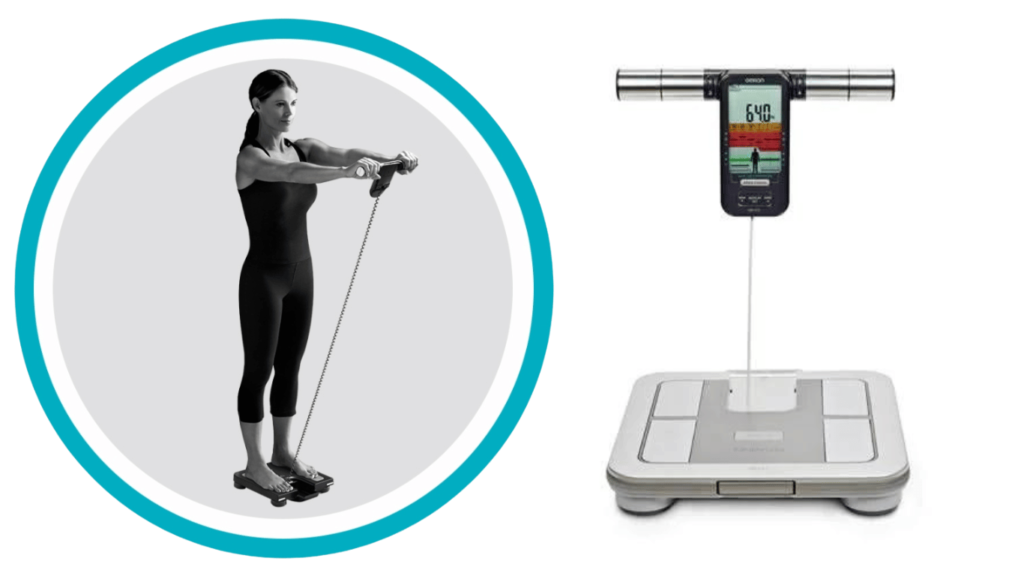Know your Body Fat Percentage at Home
Body composition and body fat percentage are interconnected ideas, as they both are related to the distribution of fat, muscle, bone, and other tissues within a person’s body. Your body fat percentage is closely related to your body composition.
Body Fat Percentage
- Your body fat percentage (BFP) is the proportion of fat tissue in respect to your whole body weight
- Usually shown as a percentage, it can be calculated by first dividing the weight of your fat mass by your entire body weight then multiplying the outcome by 100.
- Evaluating your general fitness and health depends on knowing your body fat percentage. Too much body fat greatly increases your risk of major medical problems, including diabetes, heart disease, and several forms of cancer
- One should realize that some body fat is actually good for general health. Among the various vital functions fat does in the body are those of storing energy, insulating, and hormone control.
Body Composition
- Body composition is the arrangement of the several tissues—fat, muscle, bone, water—that make up the body.
- I provides a whole view of the body’s composition rather than only gauging body fat ratio.
B tracking changes in muscle mass, fat mass, and other components over time, body composition analysis offers important new perspectives on a person’s general health and fitness.
Bdy composition can be evaluated via bioelectrical impedance analysis (BIA), dual-energy X-ray absorptiometry (DEXA), hydrostatic weighing, and skinfold measures among other approaches.
To handy metrics of health and exercise are body composition and body fat percentage. Although the body composition indicates more about the distribution of fat, muscle, bone, and water in your body, the body fat ratio informs you just how much fat tissue you have. Monitoring these indicators will enable individuals to create and meet their targets for general health, weight loss, and fitness.
- The composition of the body refers to how different tissues, like fat, muscle, bone, and water, are distributed throughout the body.
- It does more than just measure body fat ratio; it gives a full picture of the body’s make-up.
- Body composition analysis provides valuable insights into a person’s overall health and fitness by monitoring changes in muscle mass, fat mass, and other components over time.
- Various methods can be used to assess body composition, including bioelectrical impedance analysis (BIA), dual-energy X-ray absorptiometry (DEXA), hydrostatic weighing, and skinfold measurements.
Body composition and body fat percentage are both useful ways to measure health and exercise. The body fat ratio tells you exactly how much fat tissue you have, but the body composition tells you more about how fat, muscle, bone, and water are distributed in your body. Keeping an eye on these metrics can help people set and reach their goals for fitness, weight loss, and general health.
Bioelectrical impedance analysis (BIA): To estimate body fat percentage

Bioelectrical impedance analysis (BIA) is a widely used method for estimating body fat percentage. There are professional BIA devices that you can use, but if you prefer something more convenient, there are also consumer-grade scales equipped with BIA technology that you can use in the comfort of your own home. Here’s a simple method you can use to measure your body fat percentage at home using BIA:
Precautions Before Scanning
- Keep the scan machine on a dry, flat, and smooth surface.
- Find out the person’s height, age, and gender to feed into the scanner.
- The person being tested must have palms and feet free of oil and dust.
- Now, the person being tested should make sure their feet stay on the scanner’s conducting plate and hold the conducting hand carefully at a right angle.
- The person who is being scanned must breathe normally, slowly, and deeply than they usually would.
- Wait for the final scan reading.
Parameters associated with BIA measurement:
Bioelectrical assessment devices, generally known as bioelectrical impedance analysis (BIA) machines, utilize the principles of electrical conductivity to provide insights into many components of a person’s body composition. An outline of the parameters that these machines usually evaluate is as follows:
Weight:
Total body weight, which is the sum of all tissue masses, including muscle, fat, bone, and organs, is measured using bioelectrical assessment equipment. Although weight by itself doesn’t give a clear image of body composition, it is a crucial factor in determining general health and fitness.
Total body fat:
A person’s total body fat content is calculated by BIA machines as a proportion of their total body weight. This measurement is useful for evaluating an individual’s body composition and figuring out whether their proportion of body fat to weight is within a healthy range.
Age of Body:
A person’s “body age,” or an estimate of their physiological age based on variables including body composition, metabolic rate, and other health markers, is determined using certain bioelectrical assessment equipment. Agencies provide people with information about their general health and act as a catalyst for changing to a healthier way of living.
Visceral body fat:
Visceral fat is defined as fat that is accumulated in the abdominal cavity around the organs. It is linked to a higher risk of heart disease, diabetes, and metabolic syndrome, among other health issues. By estimating visceral fat levels, BIA machines can guide efforts to reduce visceral fat and help people understand their risk for specific health issues.
RMR, or resting metabolic rate:
The amount of energy your body requires to sustain essential physiological processes while at rest is known as your resting metabolic rate. RMR can be estimated by some bioelectrical assessment devices, which is helpful for those who want to control their weight, maximize their nutrition, and schedule their caloric intake.
Subcutaneous body fat:
The fat that is kept under the skin is called subcutaneous fat. Although subcutaneous fat is required for insulation and energy storage, too much of it can lead to obesity and other health problems. Subcutaneous fat levels can be estimated using BIA devices, which enables people to track changes in their body composition and adjust their lifestyle choices.
Bone Muscles:
The quantity of skeletal muscle mass in the body is also estimated using bioelectrical assessment equipment., Strengthmobility, and general metabolic health all depend on skeletal muscle mass; thus, athletes, people going through fitness training, and those trying to maintain their muscle mass as they age should pay attention to changes in muscle mass. All things considered, bioelectrical evaluation devices provide a convenient and non-invasive means to evaluate several facets of body composition, giving useful information to those who want to get healthier, more fit, and generally feel better about themselves.
FAQ
Safe levels of visceral fat can differ between males and females because of variations in body composition and hormonal factors. Let’s talk about the recommended levels of visceral fat for both males and females:
- Typically, it is considered safe for males to have less than 10% of total body fat as visceral fat. while females to have less than 8-9% of total body fat as visceral fat
- Having excess visceral fat in your body can significantly raise your chances of developing cardiovascular diseases such as heart attacks, strokes, and atherosclerosis.
- Excess visceral fat can cause insulin resistance, which in turn can lead to higher blood sugar levels and a greater likelihood of developing type 2 diabetes.
- abnormal levels of cholesterol and triglycerides in the blood.
- can have hypertension, which is a major risk factor for heart disease, stroke, and kidney disease.
Metabolic syndrome is a significant factor that can raise the chances of developing heart disease, stroke, type 2 diabetes, etc. .


